1993 VOLKSWAGEN GOLF check oil
[x] Cancel search: check oilPage 48 of 156
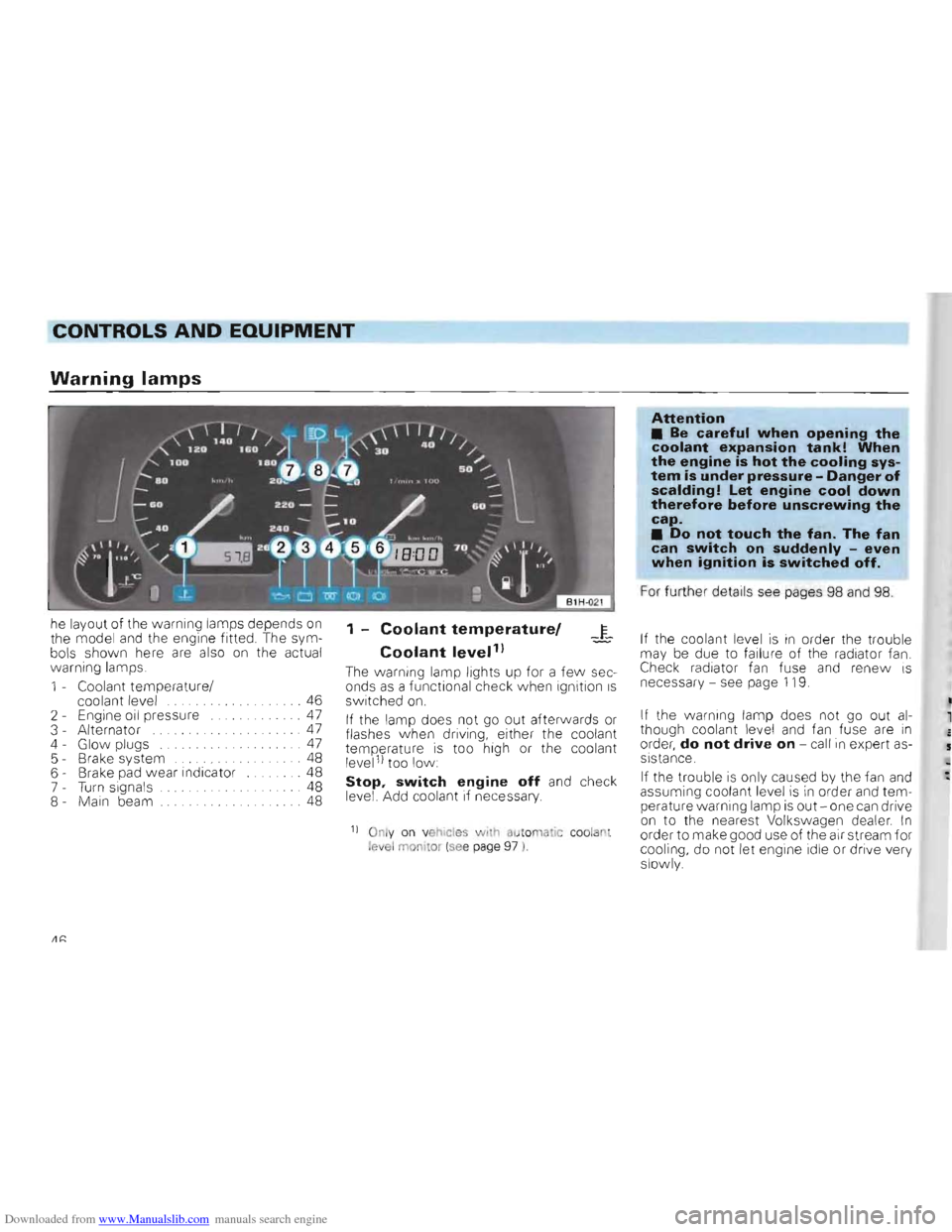
Downloaded from www.Manualslib.com manuals search engine CONTROLS AND EQUIPMENT
Warning lamps
Attention • Be careful when opening the coolant expansion tank! When the engine is hot the cooling system is under pressure -Danger of scalding! Let engine cool down therefore before unscrewing the cap_
• Do not touch the fan. The fan can switch on suddenly -even when ignition is switched off.
For furthe r details see pages 98 and 98.
1 -Coolant temperaturel _~_ If the coolant le vel is in orde r the trouble Coolant level') may be due to failure of the radiato r fan.
Check radiator fan fuse and renew is
T he wa rni ng lamp lights up for a few sec
necessary -see page 119.onds as a functional check when ign ition IS coo lant level .
. 46 switched on.
2 - Engine oil pressure ... .. 47 If the warning lamp does not go out al
If the lamp does not go out afterwards or 3 -Alternator . 47 though coolant level and fan fuse are inflashes when driving, either the coolant 4 -Glow plugs ... 47 orde r, do not drive on -call in expe rt astempe ratur e is too high or the coolant 5 -Brake system .. 48 sistance
.
level1 l too low: 6 -Brake pad wear indicator .48 If the trouble is only caused by the fan andStop, switch engine off and check7 -Turn signals 48
assuming coolant level is in order and temlevel . Add coolant if necessary . 8 -Main beam .
48
perature warning lamp is out -one can drive on to the nearest Volkswagen dealer. In 11 Only 011 vehicl es wi h a t omatic coolant order to make good use of the air stream for level lllonit or (see page 97 l. cooling , do not let engine idle or drive very
slowly .
he
layout
of the warning lamps depends on the model and the engine fitted. The sym
bols shown here are also on the actual
warn ing lamps.
1 -Coolant temperature /
Page 49 of 156
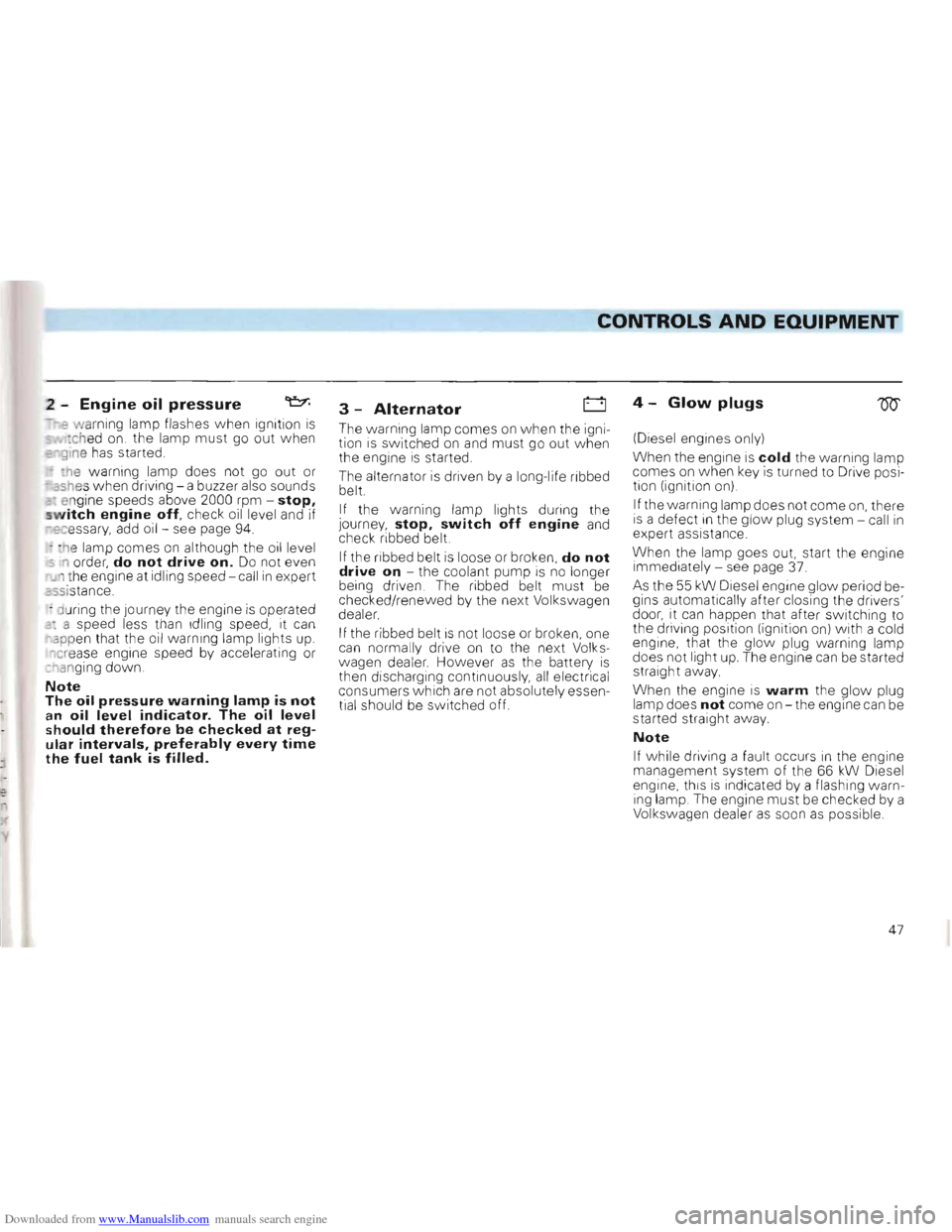
Downloaded from www.Manualslib.com manuals search engine CONTROLS AND EQUIPMENT
2 -Engine oil pressure ~
e wa rning lamp flashes when ignition is :ched on. the lamp must go out when ,=~g ne has started.
, 'Il e warning lamp does not go out or
ash es when driving -a buzzer also sounds
-' e!,gine spe,eds above 2000 rpm -stop, switch engine off, check oil level and if ecessary, add oil -see page 94.
- - he lamp comes
on although the oil level 5 n order, do not drive on. Do not even "'., t he engine at idling speed -call in expert ~slstance.
-du ring the Journe y the engine is operated
a : a speed less than idling speed, it ca n ~ appen that the oil warning lamp lights up. "crease engine speed by accelerating or :'langing down .
Note Th e oil pressure warning lamp is not an oil level indicator. The oil level shou.'d therefore be checked at reg, ular Intervals, preferably every time the fuel tank is filled.J
3 -Alternator
The warning lamp comes on w hen the igni
tion IS sWitched on and must go out when
the engine is started .
The alternator
is driven by a long-life ribbed
belt.
If the warning lamp lights during the
Journey ,
stop, switch off engine and
check ribbed belt.
If
t~e ribbed belt is loose or broken, do not
drive on -the coolant pump is no longer
being driven. The ribbed belt must be
checked/renewed by the next Volkswagen
dealer.
If the ribbed belt
is not loose or broken, one
can normally drive on to the next Vo lks
wag en dea ler. However as the battery is
then discharging co ntinuously , all electrical
consumers which are not absolutely essen
tial should be switched off.
4 -Glow plugs
(Diesel engines only)
When the engine
is cold the w arning lamp
come s on when key IS turned to Drive posi
tion (ignition on)
If the warning lamp does not come on, there IS a defectln the glow plug system -call in expert assistance.
When the lamp goes out, start the engine
Immediately -see page 37.
As the 55 kWDiesel engine glow period be
gins automatically after closing the drivers'
door,
It can happen that after switching to
the driving position (Ignition on) with a cold
engine, that the glow plug warning lamp
does not light up . The engine
can be started
straight away
When the engine
is warm the glow plug
lamp does not come on -the engine ca n be started straight away
Note
If while driving a fault occurs in the engine
management system of the 66 kW Diesel
engine, this
is indicated by a flashing warnIng lamp The engine must be checked by a
Volkswagen dealer as soon as possible.
47
Page 75 of 156
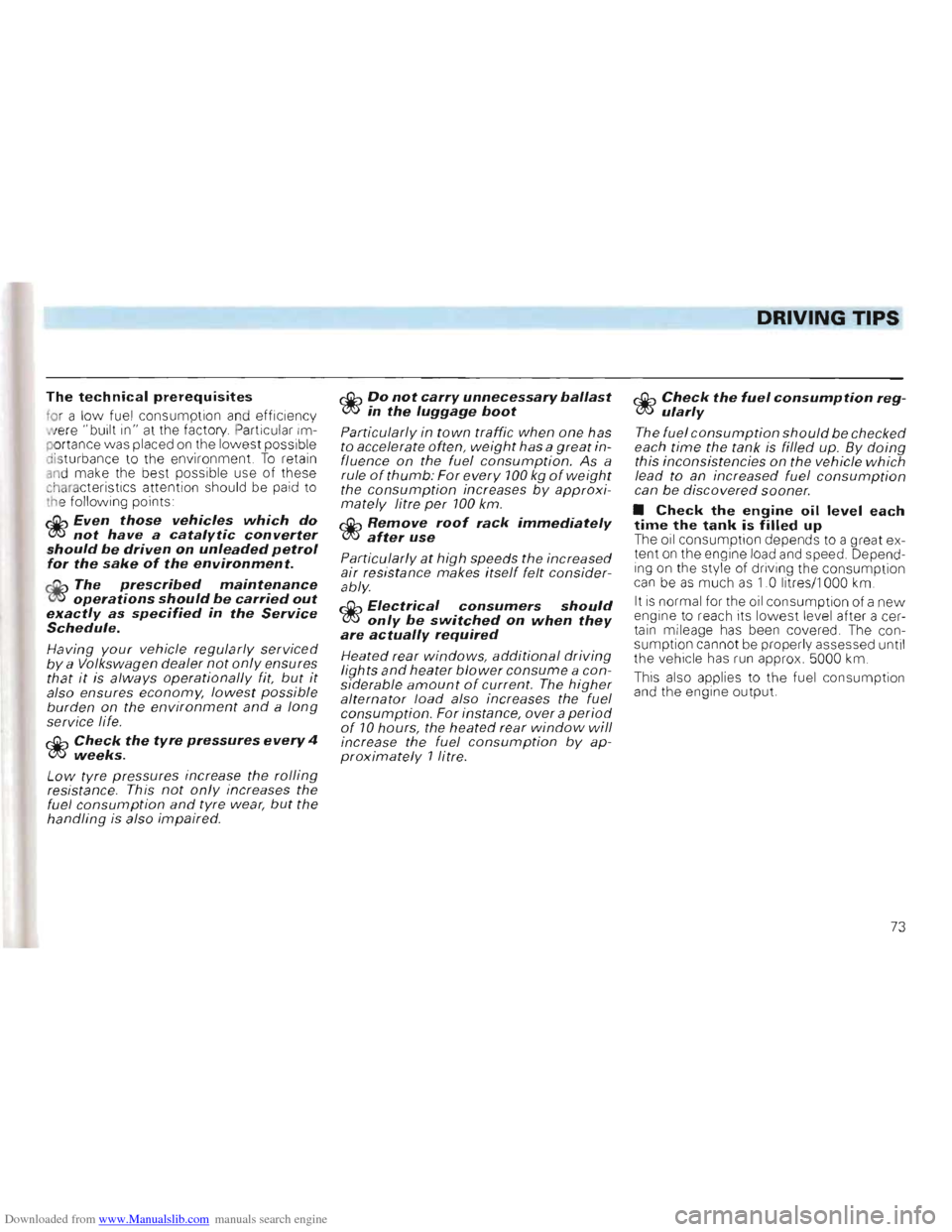
Downloaded from www.Manualslib.com manuals search engine DRIVING TIPS
The technical prerequisites
for a low fuel consumpt ion and efficienc y "" ere " built in" at the factory. Particular Im
p ortance was placed on the lowes t possible
d is turban ce to the enviro nme nt. To retain and make the best possible use of these characteristics attent ion should be paid to the fo llow ing points
~Even those vehicles which do W not have a catalytic converter should be driven on unleaded petrol for the sake of the environment.
~The prescribed maintenance W operations should be carried out exactly as specified in the Service Schedule.
Having your vehicle regularly serviced by a Volkswagen dealer not only ensures that it is always operationally fit, but it also ensures economy, lowest possible burden on the environment and a long service life.
~Check the tyre pressures every 4 W weeks.
Low tyre pressures increase the rolling resistance. This not only increases the fuel consumption and tyre wear, but the handling is also impaired.
~Do not carry unnecessary ballast W in the luggage boot
Particularly in town traffic when one has to accelerate often, weight has a great influence on the fuel consumption. As a
rule ofthumb: For every 100 kg ofweight the consumption increases by approximately litre per 100 km.
~Remove roof rack immediately Wafter use
Particularly at high speeds the increased air resistance makes itself felt considerably.
~Electrical consumers should W only be switched on when they are actually required
Heated rear windows, additional driving lights and heater blower consume a considerable amount of current. The higher alternator load also increases the fuel consumption. For instance, overa period of 10 hours, the heated rear window will increase the fuel consumption by approximately 1 litre.
~Check the fuel consumption regW ularly
The fuel consumption should be checked each time the tank is filled up. By doing this inconsistencies on the vehicle which lead to an increased fuel consumption can be discovered sooner.
• Check the engine oil level each time the tank is filled up The oil consumption depends to a g reat ex
tent on the engine load and speed. Depend
ing on the style of driving the consumption
can be as much as 1 .0 litr es/1 000 km .
It
IS no rmal fo r the oil consumption of a ne w
engine to reach its lowest level after a cer
tain mileage has be en covered . The con
sumption cannot be properly assessed until
the vehicle has run appro x. 5000 km.
This also applies to the fuel consumption
and the engine output.
73
Page 77 of 156
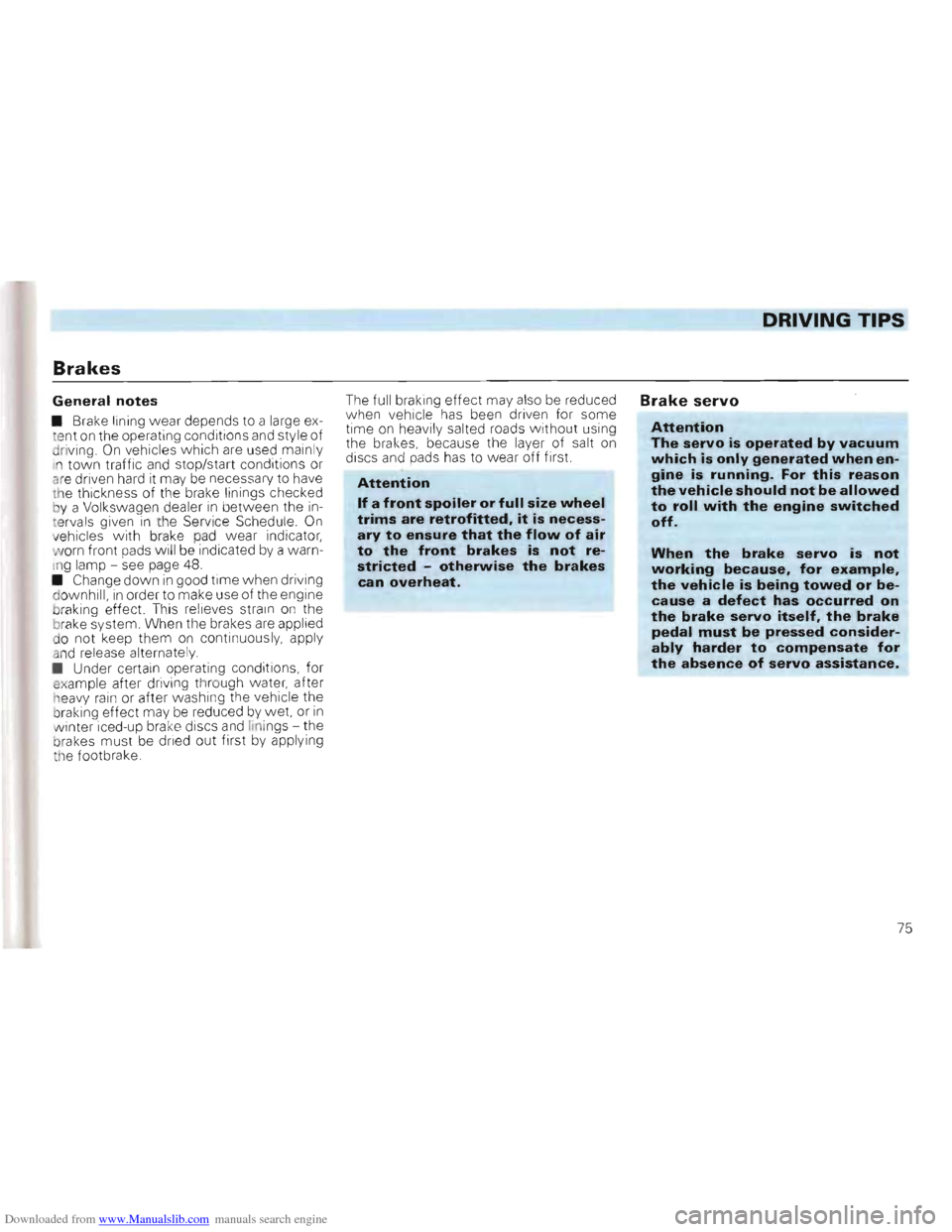
Downloaded from www.Manualslib.com manuals search engine DRIVING TIPS
Brakes
General notes
• Brake lining wear depends to a la rge ex
t e nt on the operating conditions and style of riving. On vehicles which are used mainly
n town traffi c and stop/start conditions or are driven hard it may be nece ssary to have the thickness of the brake linings checked by a Volkswagen dealer in be tween the in
t er vals given in the Ser vice Schedule. On 'ehic les with brake pad wear indicato r, worn front pads w ill b e indic ated by a wa rnIng lamp -see page 48.
• Change down in good time when driving
d ownhill , in order to make use of the engine
braking effect. This relieves strain on the
brake system . When the brakes are appl ied
d o not keep them on conti nuo usly, apply
a n d release alternately.
• Under certain
operating conditions, for
ex ample after driv ing through water, after
h eavy ra in or after washi ng the vehicle the
braking effect may be reduced by wet, or in linter iced-up brake discs and linings -the
brakes must be dried out first by applying th e footbrake. The
fu
ll braking effect may also be reduced
when vehicle has been driven for som e
tim e on heavily salted roads witho ut using the bra kes, because th e layer of salt on
discs and pads has to wear off first.
Attention
If a front spoiler or full size wheel trims are retrofitted, it is necessary to ensure that the flow of air to the front brakes is not restricted -otherwise the brakes can overheat.
Brake serve
Attention The servo is operated by vacuum which is only generated when en
gine is running. For this reason the vehicle should not be allowed to roll with the engine switched off.
When the brake servo is not working because, for example, the vehicle is being towed or because a defect has occurred on the brake servo itself, the brake pedal must be pressed considerably harder to compensate for the absence of servo assistance.
75
Page 91 of 156
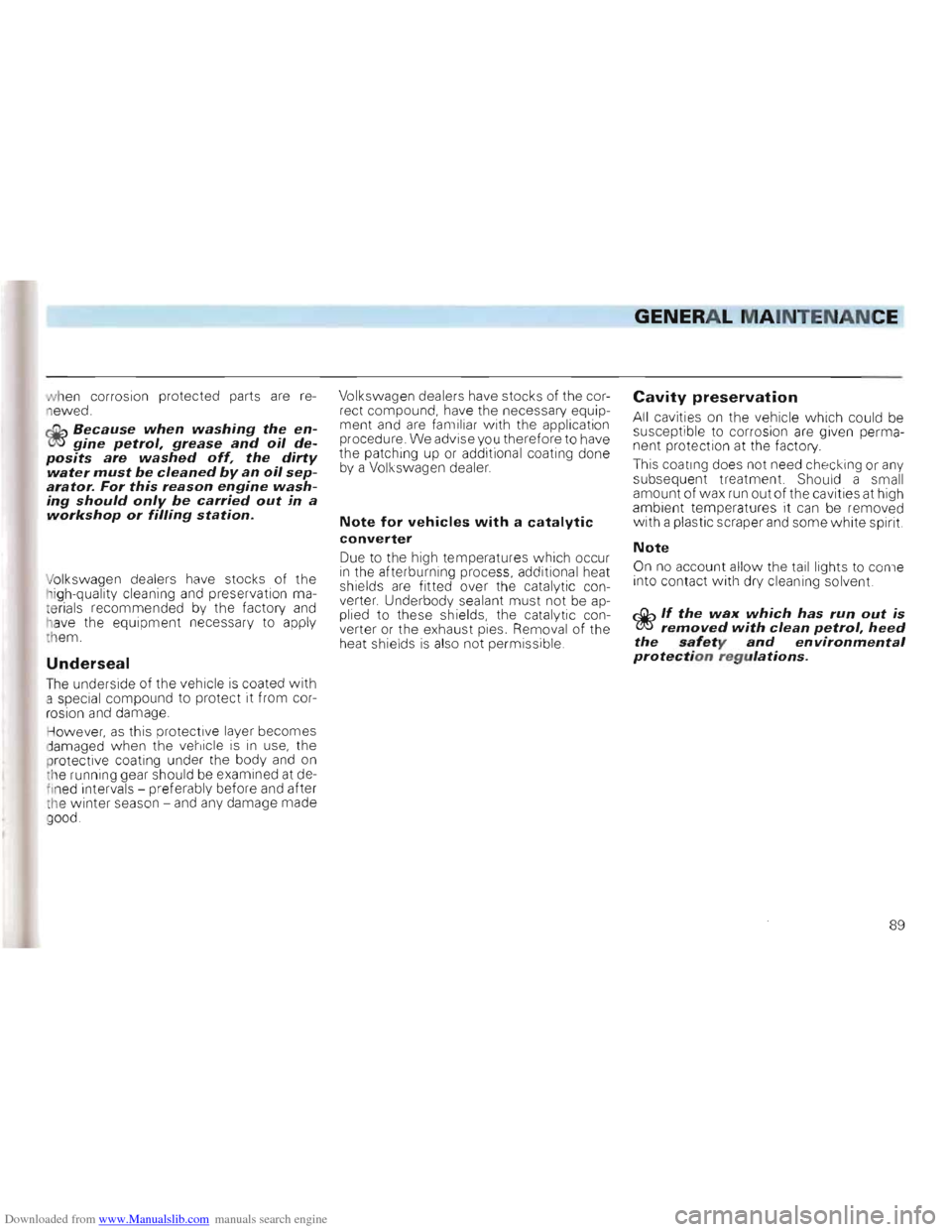
Downloaded from www.Manualslib.com manuals search engine GENERAL MAINTENANCE
w hen corrosion protected parts are reewed.
dih Because when washing the en~gine petrol, grease and oil deposits are washed off, the dirty water must be cleaned by an oil separator. For this reason engine washing should only be carried out in a workshop or filling station.
\folkswagen dealers have stocks of the
h igh-quality cleaning and prese rvation ma
te rials re commended by the factory and
have the equipment ne cessary to appl y them .
Underseal
The under side of the vehicle is coated with a special compound to protect It from cor
rosion and damage .
H ow ever,
as this protective layer becomes
a m aged when the ve hicle is in use , the
p rotecti ve coating under the body and on
t h e runn ing gear should be examined at de
fi ned inter vals -prefer ably befo re and after the winter season -and any damage made
g ood. Volksw
agen dealers have stocks of the cor
rect compound,
have the necessary equip
ment and are famil iar w ith th e application
proc edure . We advise you ther efore to have
the patching up or additional coating done by a Vol ksw agen dealer.
Note for vehicles with a catalytic
converter
Due to the high temperatures which occur in the afterburning process, additional heat
shi elds are fitted over the catalytic con
v e rter. Underbodysealant must not
be applied to the se shields, the catal ytic con
v erter or the exhaust pies. Remo val of the
heat shields is also not permissible .
Cavity preservation
All cavities on the vehicle which could be susceptible to corros ion are given perma
nent protect ion at the factory.
This coating does not need check i
ng or any
subsequent treatment. Should a small
amount
of wa x run out of the cavities at high
ambient te mperatures it can be re moved
with a plastic scraper and some white spirit.
Note
On no account allow the tail lights to com e
Into contact with dry cleaning solvent.
If the wax which has run out is removed with clean petrol, heed the safety and environmental protection regulations.
89
Page 93 of 156
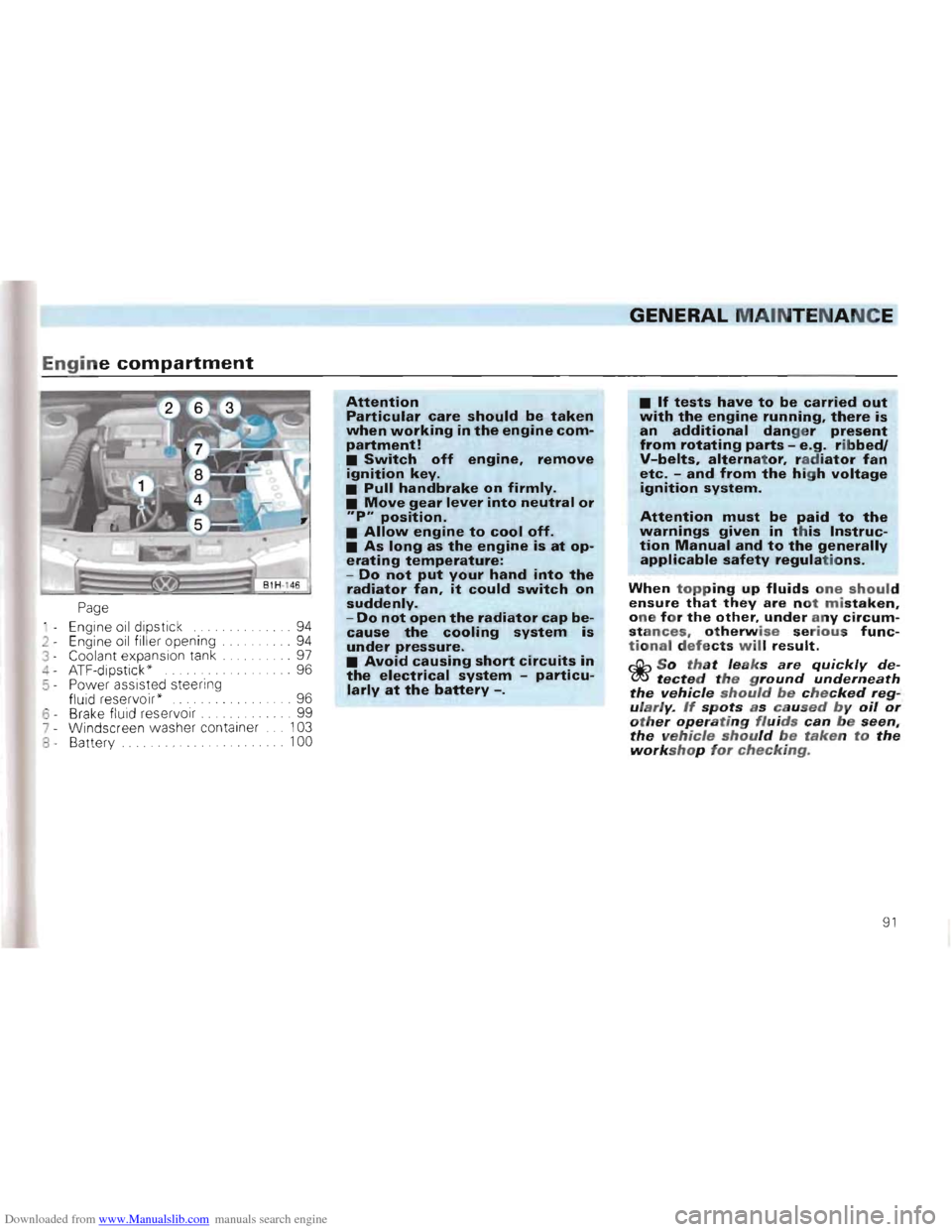
Downloaded from www.Manualslib.com manuals search engine GENERAL MAINTE NA NCE
Engine c ompartmen t
Page
Engine oil dip sti ck . . 94
2 - Eng ine o
il filler openi ng ... ...... . 94
3 - Coolant exp ansion ta nk .. 97
4 -ATF-dip sti ck " . . . . . . . . . . . .. . 96
5 - Power assist ed steering flu id r eservoir '
6 Brak e fl uid re se rvo ir .
7 - Wi nd sc reen w ash er c on tainer
8 Battery .
Attention
Particular care should be taken
when working in the engine com
partment!
• Switch off engine. remove ignition key_
•
Pull handbrake on firmly.
• Move gear lever into neutral or
"P" position.
• Allow engine to cool off.
• As long as the engine is at op
erating temperature:
-Do not put your hand into the
radiator fan. it could switch on
suddenly.
-Do not open the radiator cap be
cause the cooling system is
under pressure.
• Avoid causing short circuits in
the electrical system -particu
larly at the battery -.
. .. 96
. .. 99
10 3
100
• If tests have to be ca rried o ut with the engine running. there is an additional dang e r present from rotating parts - e.g . ribbedl V-belts, alternator, ra d iator fan etc. -and fro m the high voltage ignition system.
Attention m ust be paid to the w arn ings given in this Instruction Manual and to the generally ap plicable safety regulations.
When topp ing up fluids one should ensure that they are not mistaken. one for the other, under any circum stances. otherwise serious fu nctional defects will result.
rJjh So that leaks are quickly de(!J!J tected the ground underneath the vehicle should be checked regularly. If spots as caused by oil or other operating fluids can be seen, the vehicle should be taken to the workshop for checking.
91
Page 96 of 156
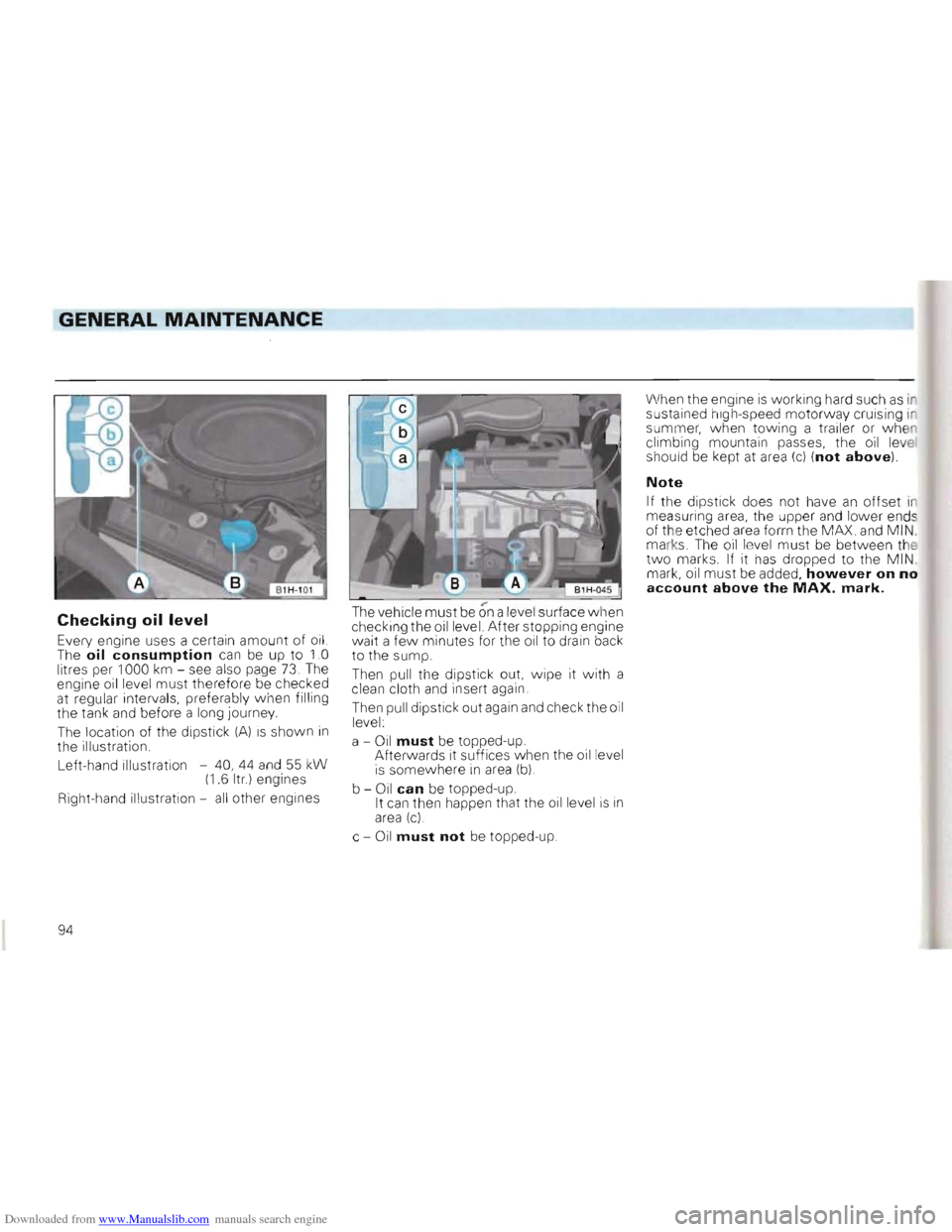
Downloaded from www.Manualslib.com manuals search engine GENERAL MAINTENANCE
Checking oil level
Every eng ine uses a certain amount of oil. The oil consumption can be up to 1.0
litr es per 1000 km -see also page 73. The
engine oil l eve l must therefore be ch ecke d
a t regula r int ervals, preferab ly w hen fillin g
the tank and before a long Journey.
The locat ion of the dipst ick (A) IS shown in th e illustration.
Left-hand illustration -40 , 44 an d
55 kW (1 .6 Itr) en gi nes
Right-hand illustration -
all other engines
The ve hicle must be on a leve l surface when checking the oil level. A fter stopping engine
wa it a fe w minutes for the oil to drain back
to the sum p.
T hen pu ll the dipstick out, wipe it with a
clean cloth and insert again
Then pull dipstick out again
and check th e oi l
level :
a -
Oil must be topped-up.
Afterwards it suffices when the oil level
is somewhere in area (b)
b -Oil can be topped-up.
I t can then happen that the oil level is in area (c)
c -Oil must not be topped-up. When
the engine
is working hard such as ir
sustained high-speed motorway cruisin g in
summer, when towing a trailer or w he n
c limbing mountain passes , the o
il lev e! should be kept at area (c) (not above).
Note
If t he dipstick does not have an offset in
meas uring area, the upper and lower ends
of the etched area forrn the MAX. and MIN .
marks. The oil level must be between the two marks. If it has dropped to the M I N . mark, oil mu st be added, however on no account above the MAX. mark.
94
Page 97 of 156
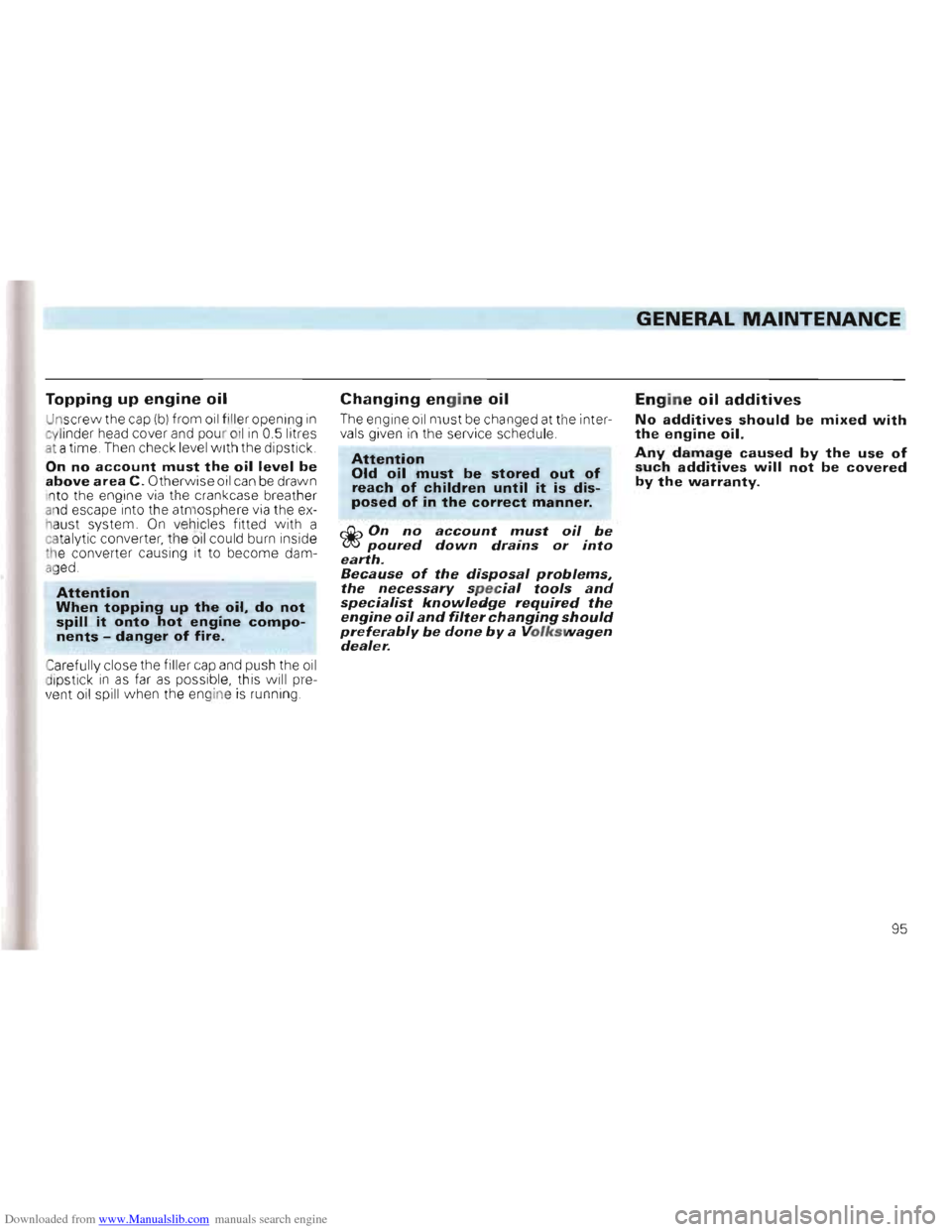
Downloaded from www.Manualslib.com manuals search engine GENERAL MAINTENANCE
Topping up engine oil
Unscrew the cap (b) from oil filler ope ning in cylinder head cover an d po ur 0 11 in 0 .5 litr es
at a time. Then check le ve l with th e dipst ic k .
On no account must the oil level be above area C . Otherwise oil can b e drawn
n to the engine via the crankcase breathe r
a n d escape into the atm osphere via th e ex·
h aust system. On ve hicl es fitted with a catalytic conve rte r, t he oil could burn inside the conve rter causing it to become dam·
a ged
Attention When topping up the oil. do not spill it onto hot engine components -danger of fire.
C arefully close the filler cap a n d push the oil ipsti ck in as far as possible, this w ill pre
vent oil spill when the engine is running .
Changing engine oil
The engine oil must be changed at the inter
v a ls g iven in the ser v ice sch e d ule .
Attention Old oil must be stored out of reach of children until it is disposed of in the correct manner,
r1Ib On no account must oil be ~poured down d,'ain s or into earth. Because of the disposal problems, the necessary special tools and specialist knowledge required the engine oiland filter ch anging should preferably be done by a Volkswagen dealer.
En gin e oil additives
No additives should be mixed with
the engine oil.
A ny damage caused by the use of
su ch additives will not be covered
by the warranty.
95